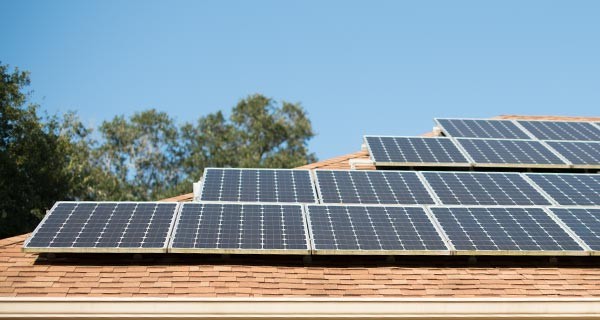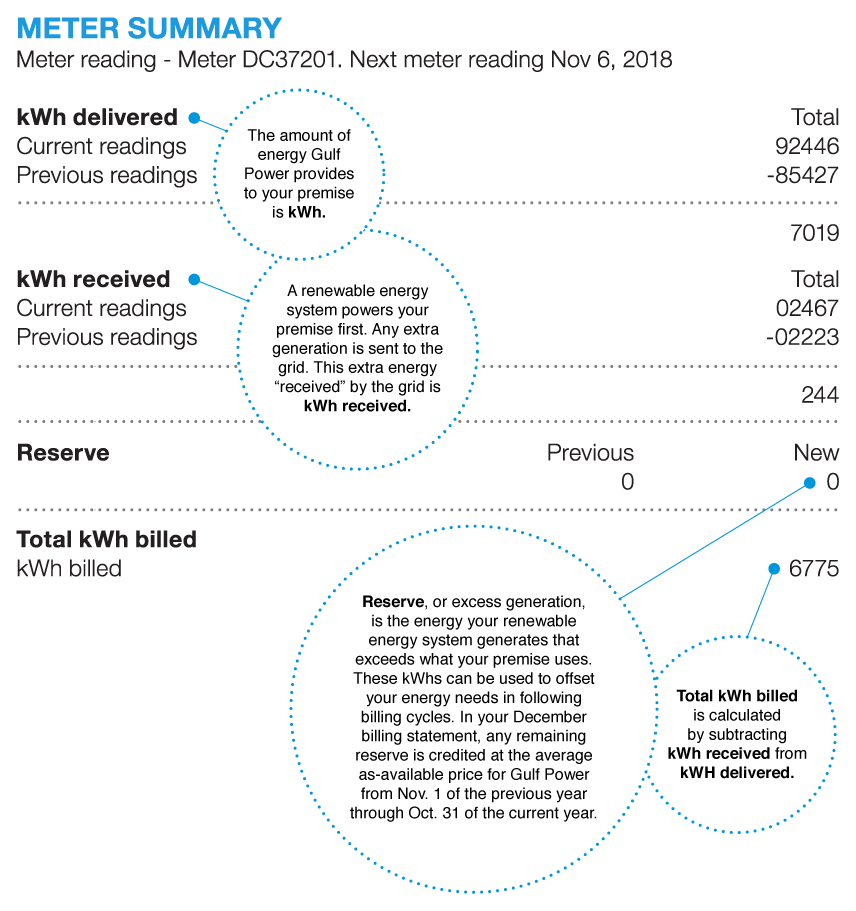Harnessing the power of the sun
Solar energy is a great way to complement the reliable electric service Gulf Power provides you every day. From solar panels to community energy share programs, we offer several options for home and business owners who are interested in renewable energy solutions. Together, we can all conserve energy and create a more sustainable future for the next generation.
Can I install solar photovoltaic (PV) panels at my home or business?
Yes, as long as the location selected is clear of obstructions that will block the sunlight. Some shading may be unavoidable, but you want it to have direct sunlight most of the time.
How do solar panels generate electricity?
Solar panels absorb energy from the sun by way of a semiconductor (typically silicon) and generate a direct current electrical source. An inverter is used to convert the source to an alternating current source.
How can I use solar panels to power my house at night?
Battery storage may be ideal for some small scale PV systems. However, this method requires additional maintenance, and can be costly. Most customers remain connected to the grid for access to continuous, reliable electricity at all times.
What size PV system do I need to power my home or business?
PV system size is directly related to how much generation you need and the available area you have. By observing your monthly and annual usage, you can calculate your ideal PV system size.
How much does a typical installed PV system cost?
The initial installed cost of a solar PV system is typically around $3.30 a watt. Therefore, a 5,000-watt system costs around $16,500. Variables specific to the installation site can increase the price significantly.
How much money will I save by installing solar on my home or business?
The estimated amount of monetary savings from installing solar is determined by analyzing two variables:
- The amount of power (stated in kWh) that the installation can generate based on the site’s surroundings.
- The amount of money invested in the installation (stated in $ per watt).
PvWatts.nrel.gov can be used to estimate the total amount of energy the solar installation can generate. (Remember, it does not consider site specific conditions such as shading from nearby trees. A thorough site analysis by a solar contractor can provide those details.)
Remember — many solar calculators only consider the amount of time it takes to pay off the initial investment. To determine if your solar installation is actually going to save you money, you must consider all of the costs associated with your solar installation: installation and equipment costs, long-term maintenance costs, additional insurance costs, unexpected damage, home improvement costs (new roof) and even possibly financing costs.
How long does a typical solar panel last?
Most solar panels are under warranty to produce 80 percent efficiency for 20-25 years, though some panels have been known to perform in excess of 40 years.
Is maintenance required for PV systems?
Yes, minimal maintenance is required. Panels should be cleaned of debris and anything else that can block the sun, to ensure maximum output. Some components may need regular inspection by a professional.
Where can I find a licensed contractor to install my solar panels or solar water heater?
Gulf Power does recommend using a solar installer who is certified by the North American Board of Certified Energy Practitioners. Learn more about NABCEP and find certified professionals in Northwest Florida.
Install solar panels
Invest in putting the sun’s energy to work for you and enjoy ongoing savings.
If you’re considering using solar panels to provide energy to your home or business, you probably have questions — about installation, cost, maintenance, return, and more.

Connect to the grid
Customers who have installed “grid-tied” renewable energy systems — up to 2 megawatts — can benefit from Net Metering, which allows Gulf Power to provide credit for any excess electricity their renewable system generates.
Read on to find requirements, how to sign up, and answers to common questions.
If I install some type of renewable generation, what will "net metering" mean to me as far as my generation, usage and billing goes?
If you decide to install renewable generation at your home or business and it meets the requirements for a Standard Interconnection Agreement under a Tier 1, 2 or 3 system, Gulf Power Company will install, if applicable, the appropriate metering at your premise. Any excess energy (kWh) received by Gulf Power from your renewable generation will be accumulated and used to offset energy (kWh) delivered to you by Gulf Power for a period of not more than 12 months. At the end of each calendar year, any unused excess energy (kWh) from your renewable generation would be credited to you using an average annual rate based on Gulf Power's avoided cost of energy throughout the year (COG-1 Schedule).
How does the Net Metering interconnection process work?
After a customer's renewable generation is installed AND inspected by the local code official the following process occurs:
- Customer completes and forwards Standard Interconnection Application and required documentation to Gulf Power
- Gulf Power reviews Standard Interconnection Application /documentation and forwards customer Interconnection Agreement
- Customer signs and returns Interconnection Agreement to Gulf Power
- Gulf Power schedules and conducts inspection
- Upon successful inspection, Gulf Power installs appropriate metering equipment and updates customer's billing data
- Gulf Power authorizes Customer to interconnect via letter
What are the requirements for Net Metering?
We have established the following interconnection requirements to protect the safety of our linemen and to maintain the quality of power the grid provides:
- Completed Standard Interconnection Application from the customer of record at the applicable address.
- Installation of solar modules or panels that meet UL1703 specifications.
- Installation of solar inverters that meet UL1741 and IEEE1547 specifications.
- Design schematic which identifies the applicable installation address and the details of the panel and inverter location and wiring methods.
- Signed Interconnection Agreement with the current customer of record at the applicable address. Permitting and inspection of the solar installation issued by the local authority having jurisdiction.
Note: Three different interconnection tiers exist with Tier 2 and 3 having additional requirements. These requirements can be found in the Interconnection Agreement for the appropriate tier.
How do I apply for interconnection and Net Metering?
Gulf Power requires that customers follow the interconnection process when considering new renewable generation or existing renewable system upgrades:
- Complete and mail a Standard Interconnection Application for Customer-Owned Renewable Generation and required documentation to Gulf Power at the following address:
- Gulf Power will review your application and documentation, and further evaluate if any other requirements exist for your specific system.
- If pre-installation documentation is approved, Gulf Power will forward the appropriate Standard Interconnection Agreement for Customer-Owned Renewable Generation to you, depending on the size on your installation.
- Your system can now be installed, if you agree to adhere to the requirements specified by Gulf Power.
- Sign and return the Agreement and the inspection report to Gulf Power at the address above.
- Gulf Power will schedule and conduct an on-site engineering verification of your equipment.
- Upon successful verification, Gulf Power will provision your meter for Net Metering.
- Gulf Power will notify you when you are authorized to turn on your renewable equipment and interconnect to the grid.
Gulf Power Company
Attn: Mass Market Renewable Analyst, Bin 231
One Energy Place
Pensacola, Florida 32520-0231
You can also submit by email to: GulfPowerNetMetering@NEE.com
Where can I download all application documents?
Below you’ll find the standard application and tier-level agreements required for your enrollment submission.
Standard Interconnection Application for Customer-Owned Renewable Generation Systems
Tier 1 Standard Interconnection Agreement for Customer-Owned Tier 1 Renewable Generation Systems (10 kW or less)
Tier 2 Standard Interconnection Agreement for Customer-Owned Tier 2 Renewable Generation Systems (Greater than 10 kW and Less than or Equal to 100 kW)
Tier 3 Standard Interconnection Agreement for Customer-Owned Tier 3 Renewable Generation Systems (Greater than 100 kW and Less than or Equal to 2 MW)
What is meant by the term "customer-owned renewable generation"?
“Customer-owned renewable generation” refers to an electric generating system located on a customer's premises that is primarily intended to offset part or all of the customer's electricity requirements with renewable energy.
Can I net meter with my whole house generator?
No. Whole house backup generators are not designed to operate in parallel with Gulf Power's electrical distribution system. Any attempt to net meter this type of generation is extremely dangerous and against the law.
Are there specific regulations and billing requirements that I should know about before installing renewable generation at my home?
There may be specific city, county, state or federal requirements for renewable generation particularly if you are considering applying for incentives or rebates; however, Gulf Power has specific requirements for interconnection to our grid.
Will Gulf Power know the total generation of my renewable energy system?
No. The meter that is used to register the net metering data for your usage and generation, will only capture what you are receiving from Gulf Power and the EXCESS generation you are delivering to Gulf Power AFTER the load requirements have been met for your home or business.
How will Net Metering credits be applied to my bill?
When your renewable energy system is approved for interconnection, the following guide will help you understand how Net Metering credits will be applied to your Gulf Power bill:

Why does Gulf Power recommend a manual disconnect switch for Tier 1 renewable generation interconnected customers, even though it is not required?
The manual disconnect switch allows the flow of energy from the customer's renewable generation source to be completely isolated from the Gulf Power grid without interrupting the flow of energy the customer receives from Gulf Power. Without a manual disconnect, it may be necessary to remove the meter in order to isolate the customer's renewable generation source, thus leaving the customer without service from Gulf Power.
What is the purpose of the application fee required for Tiers 2 and 3 on the Standard Interconnection Application for Customer-Owned Renewable Generating Systems?
Due to the additional complexity and potential impacts of these larger systems, a $477 application fee is required to cover the application review, technical analysis and on-site inspection for renewable generation systems greater than 10 kW.
Still have questions?
You can also contact our energy experts for help in finding the right solar energy solution for you.
(877) 655-4001